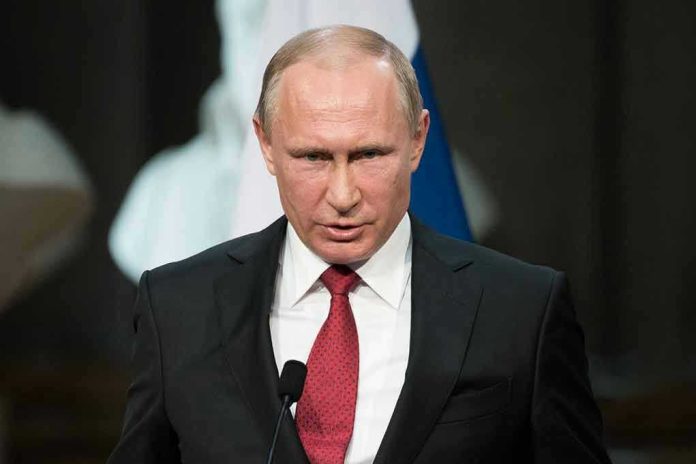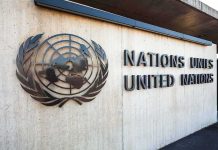
Donald Trump just did something at the UN that could redraw the map of Europe and upend decades of American foreign policy—if his words become reality.
Story Highlights
- Trump publicly reversed his stance, declaring Ukraine can reclaim all lost territory—including Crimea.
- This shift follows a failed diplomatic summit and growing Western support for Ukraine.
- Trump’s rhetoric now frames Russia as weakened and vulnerable, boosting Ukrainian morale and Western resolve.
- The move signals possible escalation in the Russia-Ukraine conflict and a seismic realignment in US policy.
Trump’s Foreign Policy Reversal: From Concessions to Total Restoration
The floor of the United Nations General Assembly buzzed with the usual diplomatic choreography. But the real action happened in the press pen, when President Donald Trump, fresh from a face-to-face with Ukraine’s Volodymyr Zelensky, dropped a bombshell: Ukraine, he declared, “can take back all territory lost to Russia—including Crimea.” For anyone tracking this conflict, the reversal was breathtaking. Only months earlier, Trump had called for Ukraine to consider ceding territory for peace, echoing years of American ambiguity and diplomatic hedging. Now, he was urging total restoration, citing Russia’s economic woes and the unwavering flow of Western support as the new levers of Ukrainian victory.
Trump’s statement came just weeks after his own Alaska Summit—intended as a last-ditch effort to broker peace—had dissolved in futility. Russia offered no new proposals. The message from Moscow: the status quo was non-negotiable. But back in New York, Trump’s tone was unapologetically hawkish. He branded Russia a “paper tiger,” predicting that Western resolve and NATO weapon shipments would tip the balance. For Zelensky, the optics couldn’t have been better. Ukraine’s president emerged from the meeting with a fresh wind at his back and a high-profile endorsement that could stiffen spines across the European Union and within NATO itself.
The War’s Shifting Calculus: Why Now?
The roots of this dramatic policy shift trace back to a war that began with Russia’s annexation of Crimea in 2014 and boiled over into a full-scale invasion in February 2022. For years, Ukraine’s losses mounted, especially in the east and south. Western capitals sent weapons and money, but always with caveats, always hedging bets. The debate over Crimea and the Donbas region never left the table. What changed? Western analysts point to Russia’s battered economy—crippled by years of sanctions and war costs—and the visible cracks in its military machine. Trump seized on these weaknesses, painting a picture of a Russia on the ropes, vulnerable to a concerted Ukrainian counteroffensive backed by Western firepower.
Trump’s new approach is as much about American leadership as it is about the facts on the ground. The message to allies is clear: Washington is no longer content to manage the conflict through half-measures. The policy now is maximalist—total restoration or nothing. The decision’s timing, on the heels of failed diplomacy and in the glare of the world’s media, signals a deliberate effort to rally Western partners and put Moscow further on the defensive. The ripple effects are already being felt in NATO capitals, where debates about aid and escalation have taken on new urgency.
Winners, Losers, and Power Plays
The primary beneficiaries of Trump’s pivot are obvious. For Ukraine, the new American stance is a game-changer, infusing its military and diplomatic corps with renewed purpose. Zelensky, long the face of Ukrainian resistance, now has the luxury of pushing for total victory rather than a bitter compromise. On the other side, Russia faces an emboldened opponent, with its own economic and military vulnerabilities now the subject of public American commentary. Trump’s framing of Russia as a diminished power—contrary to years of cautious U.S. rhetoric—may embolden NATO and EU states to double down on support, but it could also provoke unpredictable responses from the Kremlin.
Western unity is both a weapon and a liability. The U.S. and EU hold the purse strings and the arsenal, but their populations and parliaments remain wary of escalation and prolonged conflict. Trump’s move will test alliance cohesion, forcing leaders to choose between a potentially endless commitment to Ukraine’s full restoration and the risks of confronting a cornered Russia. Meanwhile, the arms industry stands to benefit from continued hostilities, and energy markets shudder at the prospect of renewed instability.
Risks, Realities, and the Road Ahead
Trump’s announcement delivers a psychological boost to Ukraine and signals to Moscow that Western patience for half-measures has run out. Yet, the path to reclaiming every inch of lost ground—especially Crimea—remains fraught with military and diplomatic peril. Experts warn of potential escalation, as Russia may see little incentive for negotiation if faced with maximalist Western demands. The risk of a protracted, grinding conflict looms large.
Long-term, this policy shift could set a new precedent for American and Western engagement in conflicts beyond Ukraine. It reasserts the primacy of U.S. leadership and might embolden other nations facing territorial disputes. Yet, the practical feasibility of Ukraine reclaiming all its territory is an open question, and the specter of a wider war cannot be ignored. As the world digests Trump’s words, one thing is certain: the old playbook is out the window—and the endgame in Ukraine is suddenly less predictable, and far more combustible, than ever.









